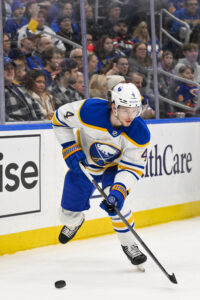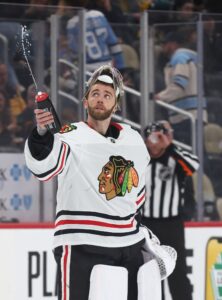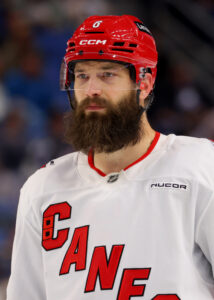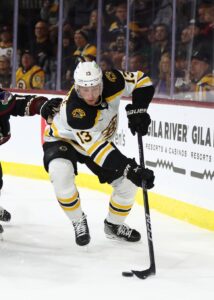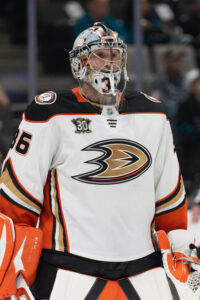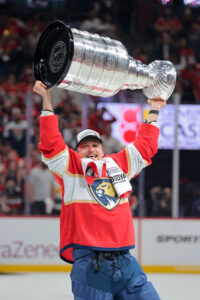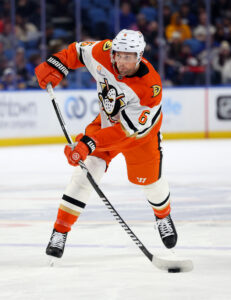With the regular season now upon us, the bulk of the heavy lifting has been done from a roster perspective. Most unrestricted free agents have found new homes, the arbitration period has come and gone, and the trade market has cooled. Accordingly, it’s a good time to take a look at what each team accomplished over the offseason. Next up is a look at the Carolina Hurricanes.
The Hurricanes have been a Stanley Cup contender for a long time. While they’ve been knocking on the door for a while, they have remained on the periphery, never advancing to a Stanley Cup Final. The Hurricanes have never been afraid to be aggressive in their pursuit of winning, but have never put it all together despite excellent coaching, a terrific NHL roster and a standout prospect system. The Hurricanes were busy this summer, making some impact moves in pursuit of a Stanley Cup, but was it enough to push them just a little bit extra they need to reach their goal?
Draft
2-41 – G Semyon Frolov, MHK Spartak Moskva Jr. (MHL)
2-49 – C Charlie Cerrato, Penn State (NCAA)
2-62 – C Ivan Ryabkin, Muskegon (USHL)
3-67 – D Kurban Limatov, Dynamo Moscow Jr. (MHL)
3-87 – D Roman Bausov, Dynamo St. Petersburg Jr. (MHL)
6-183 – LW Viggo Nordlund, Skellefteå AIK J20 (Sweden Jr.)
7-221 – RW Filip Ekberg, Ottawa (OHL)
The Hurricanes didn’t pick in the first round this year but did have three selections in the second round, taking a goalie with the 41st overall pick. Frolov moves well laterally, has good size, and tracks the puck well. He is very composed in the crease and doesn’t deviate much from his structure, even when he is making a ten bell save. On the development side, there are some concerns about consistency, and he isn’t an excellent puck handler. He also gets beaten high sometimes, the result of moving into his butterfly too early. He projects to be an NHL goaltender, with a ceiling as a potential starter.
With their second pick in the second round of the draft, Carolina chose Cerrato, a two-way NCAA center with a high hockey IQ. Besides being a skilled passer with excellent playreading, Cerrato is also a good forechecker who can kill penalties and shut things down in the defensive zone. He isn’t much of a shooter and will likely need to add some muscle if he wants to compete at the NHL level.
With their final second-round pick, Carolina chose Ryabkin from the USHL. He has good size, plays with an edge, and has goal-scoring ability. He isn’t the smoothest skater and will need to improve his agility and mobility before progressing further. That said, he plays a pro-style game and can handle physical matchups. He could eventually become a second or third-line center, but he needs refinement in certain aspects of his game, which Carolina’s coaching staff has traditionally managed well.
In the third round, the Hurricanes selected a defenseman named Limatov. Standing 6’4” and weighing 190 lbs, Limatov will likely need to add some muscle, but he isn’t afraid to play physically and skates exceptionally well, especially for his size. He moves the puck confidently and isn’t hesitant to join transition plays. He also demonstrates decent defensive skills, but must boost his consistency in the defensive zone to make the jump to the NHL. Scouts are concerned that his defensive reads reveal a poor understanding of positioning, and he relies on stick checks too often.
Trade Acquisitions
D K’Andre Miller (from New York Rangers)
G Cayden Primeau (from Montreal)
People were quite divided over the Miller trade, with many arguing that the Hurricanes gave up too many assets for him and signed him to a vibrant contract extension. There is a valid point here, considering Miller’s decline in performance last season, which raises concerns about the hefty assets and dollars Carolina invested to secure his long-term commitment.
Miller is clearly very talented offensively and is arguably one of the best skaters in the NHL. He has size and reach, highly valued traits for any team. However, his defensive game isn’t strong; at times, it’s pretty poor, and it didn’t improve during his time with the Rangers, reflecting on both Miller and the team. In Carolina, Miller will have a real opportunity to play within a structure that complements his skills. There’s no guarantee it will work, but Carolina believed he was worth taking a chance on.
From the Rangers’ perspective, the trade made complete sense after they signed Vladislav Gavrikov as a free agent. They were able to unload a young, but flawed, defenseman who was due for a massive payday, while also recouping two high draft picks and a top defensive prospect in Scott Morrow.
The jury will be out for a while on who won this trade, but it’s one to watch, especially as Morrow develops in the Rangers system.
UFA Signings
G Frederik Andersen (one year, $2.75MM)^
D Gavin Bayreuther (one year, $775K)*
LW Nikolaj Ehlers (six years, $51MM)
F Juha Jaaska (two years, $1.55MM)*^
C Tyson Jost (one year, $775K)*
D Mike Reilly (one year, $1.1MM)
LW Eric Robinson (four years, $6.8MM)^
RW Givani Smith (one year, $775K)*
*-denotes two-way contract
^-denotes re-signing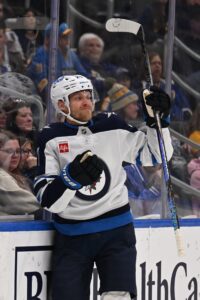
Signing Ehlers was a significant victory for the Hurricanes after they missed out on Rantanen and Guentzel long-term in previous summers. Ehlers isn’t quite at the same level as those two players, but he’s a strong top-six option who has consistently put up around 60 points for much of his career.
The six-year term shouldn’t be too restrictive for Carolina, as Ehlers will only be 35 when the deal expires, meaning he could remain reasonably productive throughout its duration. The $8.5MM AAV isn’t high either, and it should look more attractive as the deal goes on and the salary cap rises. The deal also comes at a time when Carolina has plenty of room under the salary cap, which means this probably won’t be an overpay for a free agent, assuming Ehlers stays healthy, which remains a concern.
Aside from Ehlers, Carolina remained quiet during free agency, focusing on depth and minor signings. They did, however, re-sign veteran netminder Andersen, who will once again form a tandem with the much younger Pyotr Kochetkov. Andersen is still a capable goaltender when healthy, though durability is often a concern for the 36-year-old. He appeared in just 22 games last season, but was solid in the regular season, posting a +9.0 goals saved above expected (according to MoneyPuck), and was outstanding in the playoffs with a +8.6 goals saved above expected in 13 games. While he can’t be a full-time starter, he’s an excellent option for 30-40 games.
RFA Re-Signings
RW Jackson Blake (eight years, $40,936,016)
C Skyler Brind’Amour (one year, $775K)*
D Domenick Fensore (one year, $775K)*
RW Noel Gunler (one year, $813,750)*
G Amir Miftakhov (one year, $775K)*
G Cayden Primeau (one year, $775K)
D Ronan Seeley (one year, $813,750)*
C Logan Stankoven (eight years, $48MM)
C Ryan Suzuki (one year, $775K)*
*-denotes two-way contract
The Hurricanes secured some of their key young players this summer by signing Blake and Stankoven to eight-year contract extensions. Carolina saw enough from Blake in just one season to commit long-term, and while it’s always risky to pay a player based on one year of production, they believed his potential was too significant to overlook. Blake is a skilled playmaker and an effective forechecker, but he is also somewhat small and not particularly quick. How he will develop remains uncertain, but even if his ceiling is only slightly above last year’s output, Carolina should still gain value from the deal.
The Stankoven deal was another eight-year agreement, reflecting a pattern this summer for the Hurricanes as they bet heavily on their young talent and chose to extend them the maximum term before it drops to seven years in the near future. These deals also come ahead of potential massive salary-cap increases, meaning that if Miller, Blake, and Stankoven all develop as Carolina expects, they could position themselves to be competitive for a long time. However, with Blake and Stankoven on the smaller side, injuries are always a possibility, so the risk is significant.
Stankoven’s skill is evident in the eye test, and while he struggled to score last year, he is a good transition player and an excellent playmaker who won’t shy away from contact or a battle, even if he is undersized. He posted 14 goals and 24 assists in 78 games last year, split between Dallas and Carolina, which was good enough for 7th in the Calder Trophy voting. At 22 years old, Stankoven is just scratching the surface, and the Hurricanes have taken a big bet that he has a lot more to offer.
Departures
D Brent Burns (signed by Colorado, one year, $1MM)
G Spencer Martin (signed in KHL)
D Scott Morrow (traded to New York Rangers)
D Dmitry Orlov (signed by San Jose, two years $13MM)
G Yaniv Perets (signed in AHL)
F Jack Roslovic (signed by Edmonton, one year $1.5MM)
D Riley Stillman (signed by Edmonton, two-year $1.55MM)*
C Tyson Yost (claimed on waivers by Nashville)
*-denotes two-way contract
The Hurricanes experienced quite a bit of key depth movement this summer. Up front, the only notable loss was Roslovic, who became a free agent amid expectations of securing a lucrative multi-year deal. However, that contract never materialized, and Roslovic had to settle for another one-year prove-it deal. The Hurricanes might have shown interest in Roslovic’s $1.5MM asking price, but considering their depth at center, the 22-goal scorer from last season wasn’t a priority.
On the backend, Carolina saw the majority of their departures, with Burns, Morrow, Orlov, and Stillman no longer part of the team. Burns left as a UFA and signed a one-year deal slightly above the league minimum. He could have likely stayed with the Hurricanes and served as a third-pairing defenseman, but it’s fair to wonder if the Hurricanes were hoping to go a bit younger in that spot. Burns isn’t the Norris Trophy candidate he once was, but he is still an NHL player and can serve a purpose as he tries to chase his first career Stanley Cup.
Sticking with the defense, Orlov left after two years in Carolina. The 34-year-old had a rough playoff run last year but played reasonably well in the regular season, aside from some careless puck handling as he set a career high in turnovers. With Miller coming into the picture, it made sense for the Hurricanes to let Orlov go, as they opted to go younger and maybe tried to get bigger on the backend.
Salary Cap Outlook
The Hurricanes are in good shape regarding the salary cap, sitting about $8.8MM below the threshold (according to PuckPedia). That figure translates to $36.335MM at the NHL Trade Deadline, making Carolina a team to watch as the season progresses. The Hurricanes have made significant moves during the season over the past two years, neither of which turned out very well (Jake Guentzel in 2023, Mikko Rantanen in 2024), so they might avoid going big game hunting again. However, time will tell — they have the space and the cap room to make just about any move they want.
Key Questions
Can the goaltending steal playoff games for them?
Andersen and Kochetkov have been a solid pairing for the Hurricanes for several years, but they have never been able to steal a series late in the playoffs. It’s not the reason that Carolina has never advanced to the Stanley Cup Finals, but if one of them were to stand on their head in the Conference Finals, it would go a long way to the Hurricanes finally getting over the hump. Goaltending certainly isn’t the problem in Carolina, but
Can they finally reach the Stanley Cup Finals?
It’s been a long time since Carolina was in the Stanley Cup Finals. It’ll be 20 years this spring, and they have come close to reaching the Finals in terms of the playoff bracket; however, they haven’t been competitive in any of the recent Eastern Conference Finals they’ve participated in, dating back to a 2009 sweep by the Pittsburgh Penguins. Overall, they are 1-16 in those four series and were never a threat in any of them. Teams like this have existed before—strong regular-season performers for over a decade—that ultimately fall short of winning a Stanley Cup. The Hurricanes hope they don’t become yet another cautionary tale.
Is Andrei Svechnikov going to rebound?
Svechnikov has faced a lot over the past few years, including an upper-body injury last season, which was a very inconsistent year. Coming into this season, the hopes were that the 25-year-old would bounce back, but so far, that hasn’t happened. In fact, Svechnikov is scoreless thus far and looks like a shell of his former self. Carolina is definitely concerned, but there’s plenty of season left, and maybe it’s just taking him some time to find his feet and get back up to game speed. Svechnikov is a key part of the Hurricanes’ quest to win another Stanley Cup, and if he becomes more of a liability than an asset, it could cause serious problems.
Photo by Connor Hamilton-Imagn Images
